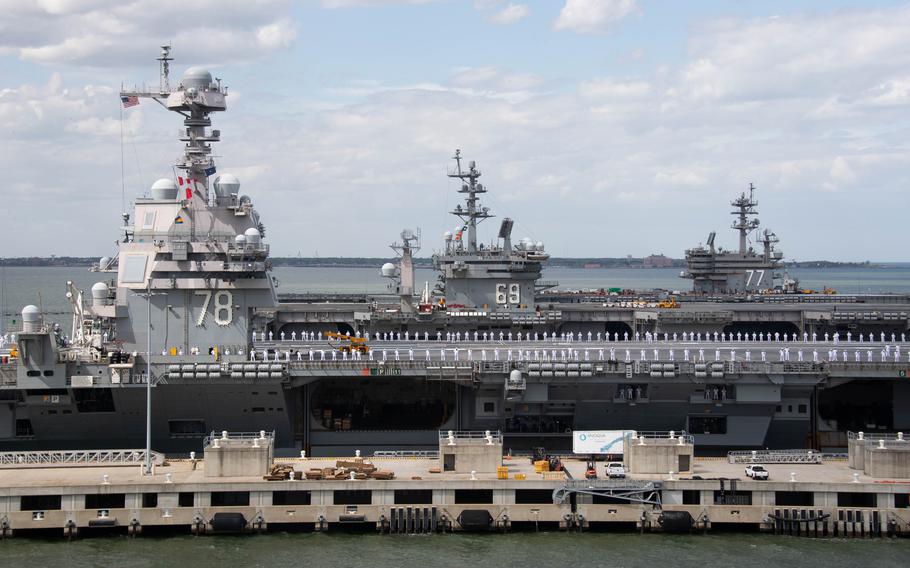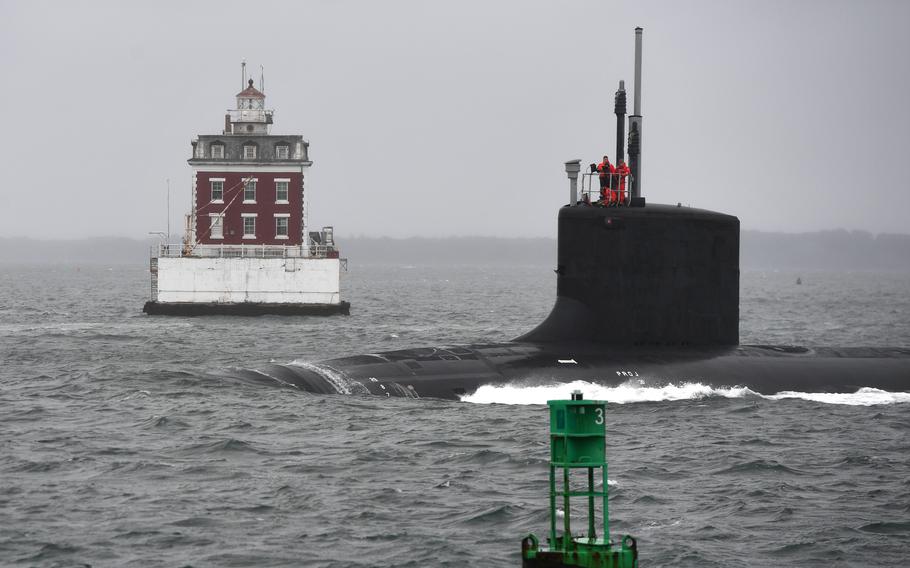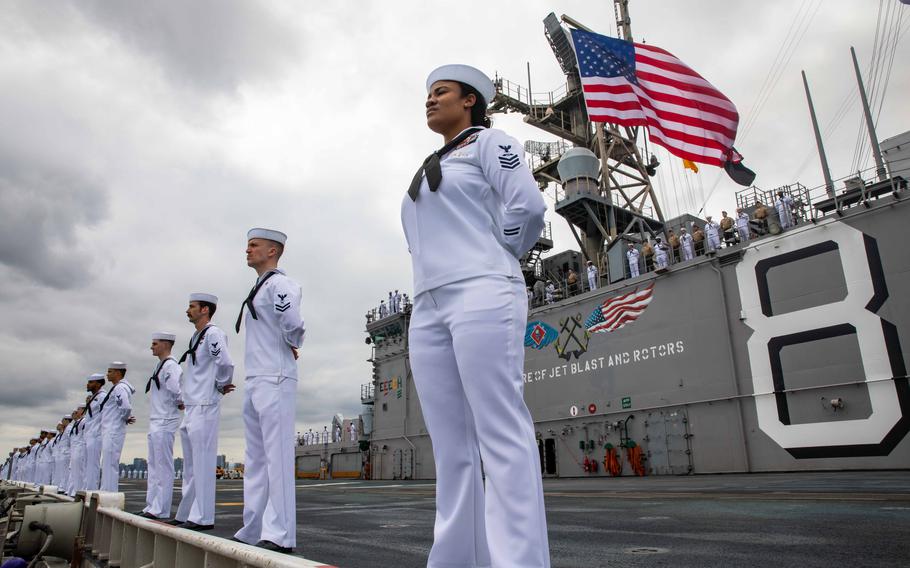
The USS Gerald R. Ford beside the USS Dwight D. Eisenhower and the USS George H. W. Bush at Naval Base Norfolk. The Navy’s 2025 budget will fund work on two new Ford-class carriers, one of which is slated to replace the Eisenhower by 2027. (Jackson Adkins/U.S. Navy)
The Navy will cut its purchase of Virginia-class submarines and F-35C Lightning II carrier-based fighter jets in fiscal 2025 amid uncertainty over budget constraints, including the 2024 defense appropriation stalled in Congress.
Navy and Defense Department officials presenting the service’s $203.9 billion budget proposal for fiscal 2025 said they face a double squeeze.
Congressional infighting has stalled the allocation of 2024 funds even as plans for 2025 are unveiled. Conflicts in the Red Sea and Ukraine and heightened tensions in the Indo-Pacific region has drained operations and munitions budgets.
“The Navy is carrying the brunt of those costs,” said Michael McCord, the undersecretary of defense comptroller and chief financial officer.
Adm. Christopher Grady, Joint Chiefs of Staff vice chairman, said Monday that the result is a budget that emphasizes current needs and the ability to respond to China in the Indo-Pacific, even if it means risking investments in future technologies and weapons.
“We’re ready to fight tonight,” he said.
The Navy proposed a pivot on its shipbuilding plans and wants to retire vessels that service officials believe do not match the profile of current and near future conflicts.

The USS Oregon, a Virginia-class submarine, passes the New London Ledge Lighthouse near Groton, Conn., in October 2022. The Navy’s fiscal 2025 budget calls for adding a Virginia-class attack submarine to the fleet. (Wesley Towner/U.S. Navy)
The fiscal 2025 budget calls for $43.1 billion in shipbuilding, including six new “battle force” additions to the fleet: One Virginia-class attack submarine, one Constellation-class guided missile frigate, two Arleigh Burke-class destroyers, one San Antonio-class amphibious transport dock, and one medium landing dock.
The budget would continue funding for the USS Enterprise and USS Doris Miller, the third and fourth of the new-generation Ford-class aircraft carriers. The ships are expected to enter service in the early 2030s.
The Navy also wants to start work on the USS Wisconsin, the second of the new Columbia-class ballistic missile submarines that also are scheduled to debut in the next decade.
The budget would allow the service to maintain 31 amphibious ships to carry Marines and other troops to conflicts. It would also meet the congressional mandate to maintain 11 aircraft carriers, a number that would go to 12 next year with the arrival of the USS John F. Kennedy, the second Ford-class aircraft carrier.
“This is a strategy-driven budget that reflects the nation’s priorities,” said Erik Raven, undersecretary of the Navy.
The Navy opted to reduce its planned request on the attack submarines from two to one and use $3.4 billion on the Pentagon’s Submarine Industrial Base plan to streamline and upgrade the supply chain of 15,000 companies in 50 states involved in submarine production.
“We need to get to a better, healthier dynamic,” McCord said of the Virginia-class production delays.
The decision drew immediate pushback from Rep. Joe Courtney of Connecticut, the top Democrat on the House Armed Services Committee’s subpanel on seapower and projection forces. His district includes General Dynamics Electric Boat, the submarine builder in Groton.
“The Navy’s plan to cut a submarine that has already been partially paid for and built makes little or no sense,” Courtney said Monday. “This hard rudder turn by the Navy demands the highest scrutiny by the Congress.”
To offset the costs of operations and new ships and submarines, the Navy wants to retire 10 ships that have yet to reach their projected end-of-service age. The list includes two Ticonderoga-class cruisers, four expeditionary transports, two littoral combat ships, and one expeditionary transport dock ship.

Sailors aboard the USS Makin Island "man the rails" at Naval Base San Diego in June 2023. The Navy's 2025 budget calls for 390,000 sailors and officers in the service — 332,300 on active duty and 57,700 in reserves. (Eloise A. Johnson/U.S. Navy)
Another procurement casualty would be the Lockheed-Martin F-35C Lightning II aircraft slated to replace the McDonnell-Douglas F/A-18 Hornet as the Navy’s main carrier-launched fighter and attack aircraft. The Navy will buy 13 F-35Cs, which Navy or Marine squadrons can fly off aircraft carriers.
McCord said the new plane’s development issues, including software problems, were affecting deliveries. He said just as the Virginia submarine program could get back on track with a production slowdown, a longer delivery runway for the F-35C could allow for a catch-up between demand and supply.
Raven said allowing the Navy to make the choices was critical as congressionally mandated limits constrain future budgets.
“We’re moving into a capped environment,” he said. “We looked at our own programs and made trades with a clear understanding of the risks we are taking.”
If the Navy shipbuilding and retirement plan is approved, the service would drop from 296 ships now to 287 in 2025. The fleet would include 11 aircraft carriers and 67 nuclear-powered attack and ballistic-missile submarines.
Personnel would also remain essentially flat under the budget.
The Navy wants 332,300 active-duty sailors, up from its current 331,221. As with the other military services, the Navy has fallen short of recruiting goals. The Navy remains below its 2024 authorized force size of 337,800 personnel. The service also wants to increase the Reserve in 2025 from 55,979 to 57,700.
The budget did not include money needed to replenish missiles and other ammunition expended in operations in the Middle East. The Defense Department and Navy plan to submit a supplemental budget to cover the costs of current conflicts.
Rear Adm. Ben Reynolds, deputy assistant secretary of the Navy for budget, said the service needed a return to annual budgets with funds matching costs. The current short-term funding measures and caps aren’t sustainable.
“It can cause lasting and profound damage to the Navy and Marine Corps,” he said.